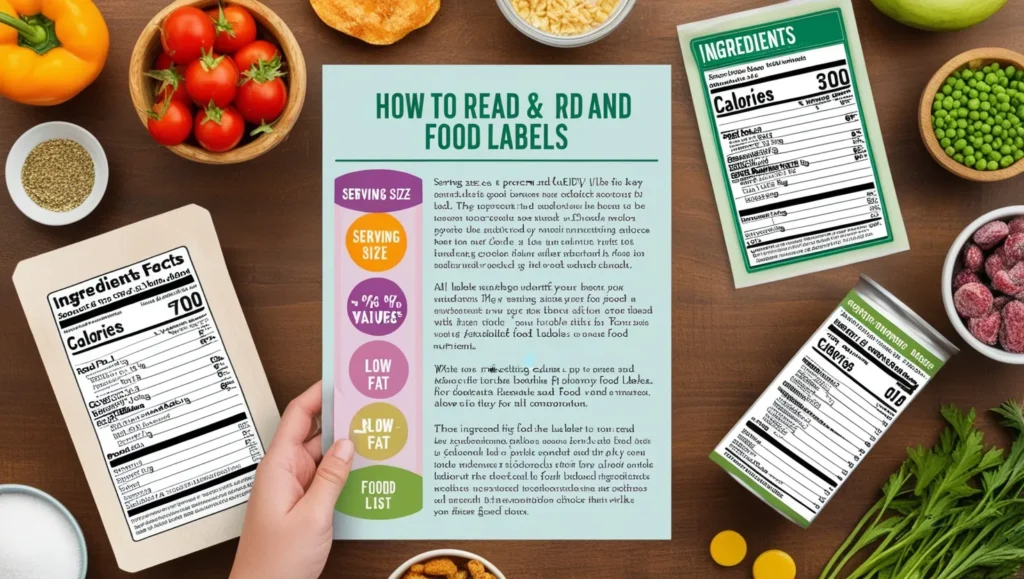Understanding Food Labels What You Should Know
When it comes to making informed choices about the foods you eat, understanding food labels is crucial. Food labels provide vital information about the nutritional content, ingredients, and health claims of packaged foods, helping you make decisions that align with your dietary needs and health goals. However, deciphering these labels can often feel overwhelming. This guide breaks down the essential components of food labels so you can confidently navigate the grocery aisle.
1. Why Food Labels Matter
Food labels are more than just a list of ingredients and nutritional facts; they are a tool for transparency and accountability. They allow you to:
- Monitor Nutritional Intake: Understand the macronutrient and micronutrient content of your food.
- Identify Allergens: Spot potential allergens like nuts, gluten, or dairy.
- Avoid Unwanted Additives: Identify artificial flavors, preservatives, or other substances you may want to limit.
- Meet Dietary Goals: Stay on track with calorie counts, sugar intake, or specific diets like keto or gluten-free.
Understanding food labels empowers consumers to make choices that support their health and lifestyle.
2. Key Components of Food Labels
Here’s a breakdown of the key sections on food labels and how to interpret them:
a. Serving Size
The serving size is the first thing you should note. It indicates the portion size that the nutritional facts are based on.
Why It’s Important:
- Helps you understand how much of each nutrient you’ll consume if you eat the stated portion.
- Prevents over- or underestimating calorie and nutrient intake.
Tip: If you eat more or less than the stated serving size, adjust the nutritional values accordingly.
b. Calories
Calories indicate the amount of energy the food provides.
What to Look For:
- The number of calories per serving.
- Consider your daily caloric needs when deciding if the food fits your goals.
c. Macronutrients (Fats, Carbohydrates, Protein)
- Fats:
- Total Fat: Includes all types of fat in the product.
- Saturated Fat: Aim to limit saturated fat to less than 10% of your daily calorie intake.
- Trans Fat: Look for “0g,” as trans fats are harmful and linked to heart disease.
- Carbohydrates:
- Total Carbs: Includes sugars, dietary fiber, and complex carbs.
- Dietary Fiber: Foods with high fiber content are beneficial for digestion and heart health.
- Sugars: Be cautious with added sugars; they can contribute to weight gain and other health issues.
- Protein:
- Vital for muscle repair and overall health. Look for protein-rich foods if you have high protein requirements.
d. Micronutrients (Vitamins and Minerals)
Food labels also highlight key vitamins and minerals, such as Vitamin D, Calcium, Iron, and Potassium.
Why It’s Important:
- Helps you meet daily recommended intakes.
- Supports overall health, such as bone strength and immunity.
e. Percent Daily Values (%DV)
The %DV shows how much a nutrient in a serving contributes to your daily diet, based on a 2,000-calorie-per-day diet.
What to Note:
- 5% or Less: Low in a nutrient (e.g., sodium).
- 20% or More: High in a nutrient (e.g., Vitamin C).
f. Ingredients List
The ingredients list is ordered by weight, meaning the first few ingredients make up the largest portion of the food.
What to Look For:
- Avoid foods where sugar or unhealthy fats are listed as the first ingredients.
- Opt for items with recognizable, whole-food ingredients.
g. Allergen Information
Common allergens such as peanuts, soy, wheat, or dairy must be listed.
3. Decoding Food Label Claims
Marketing terms on packaging can sometimes be misleading. Here’s how to interpret common claims:
- “Natural”: Not regulated strictly; it doesn’t always mean healthy or free from additives.
- “Organic”: Certified organic products meet strict guidelines for pesticide and chemical use.
- “Low-Fat” or “Fat-Free”: May contain added sugar or artificial flavors to compensate for taste.
- “Sugar-Free” or “No Added Sugar”: “Sugar-free” means less than 0.5g of sugar per serving, while “no added sugar” may still contain natural sugars.
- “Gluten-Free”: Certified to contain less than 20 ppm of gluten, safe for those with gluten intolerance or celiac disease.
4. Tips for Using Food Labels Effectively
- Prioritize Nutrients That Matter Most to You:
- If you’re managing diabetes, focus on carbohydrates and sugars. For heart health, monitor sodium and fats.
- Compare Products:
- When deciding between brands, use the nutritional facts to pick the healthier option.
- Watch for Hidden Sugars:
- Look for terms like high fructose corn syrup, agave nectar, or dextrose in the ingredients list.
- Don’t Be Swayed by Packaging:
- Always check the full label instead of relying on front-of-package claims.
5. Common Misconceptions About Food Labels
- “Low-calorie” Means Healthy: Not always. It could be low in calories but high in artificial additives.
- Serving Size Equals Entire Package: Many packages contain multiple servings, so read carefully.
- “Cholesterol-Free” Equals Heart Healthy: Cholesterol content doesn’t always reflect saturated or trans fat levels.
Final Thoughts
Understanding food labels equips you to make healthier, more informed choices for yourself and your family. By taking the time to read and interpret labels, you can align your eating habits with your health goals, avoid misleading claims, and select products that truly nourish your body.
Next time you’re at the grocery store, take a moment to examine the food labels—it’s a small step that can lead to significant improvements in your overall well-being.


